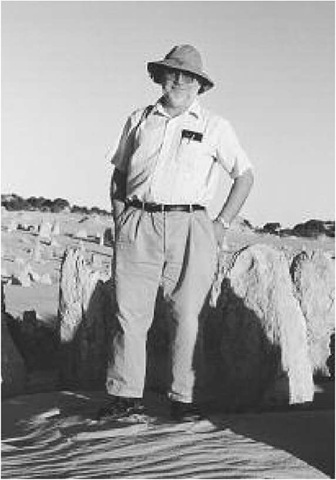(1938- ) American Structural Geologist, Tectonics
The general public may best know Eldridge Moores as a central character in the John McPhee book Assembling California. His work in California, Cyprus, and as a mentor are described in detail in addition to some of his personal life. In the Earth science profession, Eldridge Moores is known as the world’s foremost expert on ophio-lites. Ophiolites are chunks of ocean crust that are exposed on land. Typically, they are plucked away from the ocean floor during collisional events and then transported a great distance on major faults until they wind up in the mountains. They go from the deepest parts of the Earth’s surface to the highest in a single event. Traditionally, they are made up of three parts known as Steinman’s Trinity: a base of ultramafic rock (peridotite), sheeted dikes cutting layered pillow lava in the middle, and layered deep-ocean sediments on top. However, all of the parts are not always there. The ultramafic base has become the more common element to be studied or at least used for identification. Eldridge Moores recognized the significance of these rocks as records of lost ocean basins. They commonly mark the suture zone between two ancient tectonic plates and therefore are significant finds for plate tectonic reconstructions. Moores has studied ophiolites in Cyprus (the famous Troodos Complex), in Greece (Vouri-nos complex), Pakistan, western Nevada, and those that formed during the Precambrian. More recently, he has been studying processes of seafloor spreading as revealed through these ophi-olites. Examples of Moores’s publications on this work include Ophiolites and Oceanic Crust, Geo-tectonic Significance of Ultramafic Rocks, and Ancient Sutures Within Continents.
Moores is also an expert on California geology. He did research on basement rocks of the Sierra Nevada, the Klamath Mountains, and the surrounding areas. These studies include meta-morphic petrology, geochronology, structural geology, and regional tectonics. He worked on the Franciscan subduction melange of the northern coast ranges. He also studied neotectonics of this area as well as that of the Great Valley. He led several field conferences in these areas and published some of the seminal papers and edited volumes on California geology.
Eldridge Moores was born on October 13, 1938, in Phoenix, Arizona, where he grew up. He attended the California Institute of Technology, where he graduated with a bachelor of science degree in geology with honors in 1959. He earned a master of arts degree and a Ph.D. from Princeton University, New Jersey, in geology in 1961 and 1963, respectively. His adviser was harry h. hess, the world’s preeminent expert on ultramafic rocks at the time. Eldridge Moores was awarded a postdoctoral fellowship at Princeton University for the years of 1963-66 to study the Vourinos ophiolite complex in northern Greece. He joined the faculty at the University of California at Davis in 1966, where he remains as of 2002. Eldridge Moores is married with three children and enjoys languages, music, reading history, and hiking.
Eldridge Moores has been one of the more productive and prominent members of the geologic community. He published some 105 papers in professional journals and volumes as well as nine books and volumes. Several of these papers are in the most prestigious scientific journals like Nature and Science. Among these books are popular textbooks including Structural Geology and Tectonics, both with colleague Robert Twiss. He also assembled an often-cited collection of papers on plate tectonics entitled Shaping of the Earth, Tectonics of the Continents and Oceans, published through Scientific American. In recognition of these contributions to geology, Moores has received numerous honors and awards. He received an honorary doctor of science from the College of Wooster (Ohio) in 1996, the Distinguished Service Award from the Geological Society of America in 1988, and the Geological Association of Canada Medal in 1994. He was elected a Fellow of the California Academy of Sciences in 1996. He was also elected Honorary Fellow of the Geological Society of London in 1997.
Eldridge Moores on a field trip to the Pinnacles Desert in Western Australia
His service to the profession and especially to the Geological Society of America is stellar. Eldridge Moores served as president of that group in 1996, vice president in 1995, council member in 1988-91, and member and chair of numerous committees. He also served as editor of the high-profile journal Geology from its inception in 1981 until 1988. He served as science editor for another Geological Society of America publication, GSA Today, from its inception in 1990 to 1995. He served on many of the most prominent tectonic geology projects. He served on the advisory committee for the Consortium for Continental Reflection Profiling (COCORP) from 1980 to 1987, the panel for the National Science Foundation Continental Scientific Drilling Committee from 1981 to 1983, and he was the chair of the Ocean Drilling Project Tectonics Panel from 1990 to 1993.

